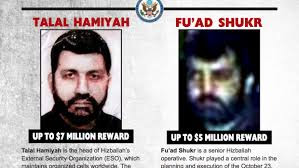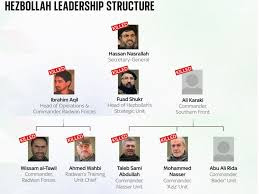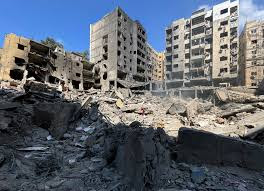(Based on staff articles from the ABC NEWS AUS and The DAILY MAIL UK.)
On October 23, 1983, Hezbollah killed 241 U.S. military personnel, including 220 Marines, 18 sailors, and three soldiers in a terrorist bombing of the Marine Corps barracks in Beirut, Lebanon. Minutes later, a second suicide bomber killed 58 French paratroopers. Six innocent Lebanese civilians also lost their lives.
The abhorrent and shocking attack on the Beirut
barracks remains to this day the single deadliest day for the U.S. Marine Corps
since the Battle of Iwo Jima. On October-23 last year United States Secretary
of State Antony J. Blinken said in the press statement that “Today, forty years
later, we mourn those service members of the Multinational Force in Lebanon
lost in both attacks and we honor their legacy.
We think of their families and friends, who continue to feel the painful
absence of loved ones.”
Almost a year later on 27 September this year, US-Proxy Israel, with the use of more than 80 American-made 2,000-pound bombs widely known as the Bunker-Busters provided free-and-abundant by the US to Israel, blew up (or liquified) a multi-storied apartment building 60 ft above the massive underground bunker being used as the Hezbollah Command-and-Control Centre in the Suburb of Dahiyeh in Beirut the Capital City of Lebanon.
Israeli Military the IDF said it took just several
minutes to drop the JDAM bombs and kill Hezbollah leadership including Hassan
Nasrallah the Hezbollah's leader, Ali Karaki the commander of Hezbollah’s
southern front, and Abbas Nilforoushan the Iranian Revolutionary Guards' deputy
commander.
1983 Beirut barracks bombings
On October 23, 1983, two truck bombs were detonated
at buildings in Beirut, Lebanon, housing American and French service members of
the Multinational Force in Lebanon (MNF), a military peacekeeping operation
during the Lebanese Civil War.
Early that Sunday morning, the first suicide bomber
detonated a truck bomb at the building serving as a barracks for the 1st
Battalion 8th Marines (Battalion Landing Team – BLT 1/8) of the 2nd Marine
Division, killing 220 marines, 18 sailors and three soldiers, making this
incident the deadliest single-day death toll for the United States Marine Corps
since the Battle of Iwo Jima in World War II and the deadliest single-day death
toll for the United States Armed Forces since the first day of the Tet Offensive
in the Vietnam War. Another 128 Americans were wounded in the blast. 13 later
died of their injuries. Explosives used were later estimated to be equivalent
to as much as 12,000 pounds (5,400 kg) of TNT.
Minutes later, a second suicide bomber struck the
nine-story Drakkar building, a few kilometers away, where the French contingent
was stationed. 55 paratroopers from the 1st Parachute Chasseur Regiment and
three paratroopers of the 9th Parachute Chasseur Regiment were killed and 15
injured. It was the single worst French military loss since the end of the
Algerian War.
The Death of Fuad Shukr
In response to the July 27 Hezbollah rocket attack
that killed twelve children in Majdal Shams, Israel carried out a precision
airstrike at an apartment building in the Haret Hreik neighborhood of Beirut,
one of the group’s strongholds. The target of the July 30 operation was Fuad
Shukr, a senior commander whom Israeli officials blamed for the Majdal Shams
attack and described as the “right-hand man” to Hezbollah leader Hassan
Nasrallah.
In the immediate term, his death removes one of the
group’s most capable military figures, who had the ear of both Nasrallah and
the top brass of Iran’s Islamic Revolutionary Guard Corps-Qods Force (IRGC-QF).
It also sends a stark message: if Hezbollah kills Israelis, then Israel will no
longer be deterred from carrying out sensitive operations deep inside Lebanon,
even against the group’s leaders in the capital.
Born in 1961 or 1962, Fuad Shukr (aka Hajj Muhsin
Chakar) spent his entire adult life moving up Hezbollah’s ranks as a terrorist
operative, soldier, and commander. He was a founding member of the Islamic
Jihad Organization, the group’s foreign operations element.
In that capacity, Shukr played a central role in
early terrorist attacks, including against Americans. In October 1983—two years
before Hezbollah formally announced its existence in an “open letter” pledging
support for Iran’s Supreme Leader and threatening violence against the West—he
helped plan and launch suicide truck bombings targeting U.S., French, and
Italian peacekeepers, killing 241 personnel at the U.S. Marine barracks in
Beirut along with 58 French personnel and 6 civilians (the Italian attack failed).
US-made bombs appear in IDF videos
The IDF released videos and photos following the Nasrallah attacks it said showed the warplanes that took part in the strike. The fighter
jets were carrying multiple 2,000-pound-class bombs, some of which were US-made
BLU-109s. The planes were equipped with Joint Direct Attack Munition (JDAM)
guidance kits, which convert "dumb bombs" into precision-guided
munitions that can attack a specific target.
Over the weekend, Senator Mark Kelly, chair of the
Senate Armed Services Airland Subcommittee, said Israel had used a US
2,000-pound Mark 84 series bomb in the strikes that killed Nasrallah.
"We see more use of guided munitions, JDAMs,
and we continue to provide those weapons," Mr Kelly said in an interview
with NBC. "That 2,000-pound bomb that was used, that's a Mark 84 series
bomb, to take out Nasrallah." Mr Biden acknowledged that the bombs, which
military experts say turn "earth into liquid", had killed civilians.
The US is Israel's longtime ally and biggest arms
supplier, but neither the Israeli military nor the Pentagon have commented on
the weapons used in the attack. Although the US announced that it had halted
shipments of heavy bombs to Israel, Israel would likely have a large stockpile.
Bombs designed to explode underground
The Mark 84, or BLU-117, is the largest in the Mark
80 series of weapons known as "bunker busters". It has a lethal
fragmentation that can extend for up to 365 metres. Malcolm Davies, senior
analyst in defence capability at the Australian Strategic Policy Institute
(ASPI), said there were different variations of the heavy bombs.
But he was confident Friday's strikes in the
Dahiyeh neighbourhood used bunker busters. "The high-yield, 2,000-pound
weapons were designed to penetrate deep underground where Nasrallah was hiding
with his cronies," he told the ABC. "So I think that that's how the
Israelis did this."
The bombs slice through concrete, then explode
underground. The explosions then create shock waves that immediately collapse
structures above. "Anyone who's not killed by the explosion on the ground
is then killed by the rubble falling on them," Dr Davis said.
Iranian moles and 2000lb bunker busters
Israel's assassination of Hezbollah leader Hassan
Nasrallah with US-made bunker-busting bombs on Friday came as the result of a
critical intelligence breach amid decades of infiltration of Iranian and
Lebanese militant command structures, it is claimed.
Nasrallah died in a brutal assault that saw Israeli
F-15I fighter jets drop dozens of munitions on the Hezbollah HQ in Beirut - a
rapid succession of strikes dubbed 'Operation New Order' that eliminated half
of Hezbollah's leadership council and decimated its top military command.
Expert analysts said the F-151s delivered 2000lb
Joint Direct Attack Munitions (JDAMs) that are designed to penetrate deep into
their targets before exploding, allowing Israel's air force to eliminate
Nasrallah even as he hid in an underground bunker some 60 feet beneath Beirut's
Dahiyeh suburb.
The F-151 fighter jets of the IAF's 69th Squadron took
off from the Hatzerim Airbase in southern Israel to carry out a strike in
Beirut against Hezbollah chief Hassan Nasrallah, September 27, 2024.
That attack came barely a week after the deadly
detonation of thousands of booby-trapped Hezbollah pagers and hundreds of
radios which killed dozens of people and left thousands injured.
A Lebanese security source informed Le Parisien
that an Iranian mole was responsible for leaking the information to Israel.
Though this is yet to be corroborated, it would constitute a devastating
intelligence breach for Hezbollah and its backers in the Islamic Republic.
Both Hezbollah and Iran's Revolutionary Guards
Corps (IRGC) now face the enormous challenge of plugging the infiltration in
its ranks that allowed its arch-enemy to destroy weapons sites, booby-trap its
communications and assassinate the veteran leader.
'Israel clearly infiltrated Hezbollah at highly
sensitive and consequential levels, killing senior command networks with
airstrikes, paralysing its communication and coordination capacity, and
grinding the organisation down, denying it time to recover and regroup thus
far,' RUSI's Senior Research Fellow for Middle East Security, Dr Burcu Ozcelik
said. 'This has been the culmination of years of complex, synchronised
intelligence-gathering in the Israeli security establishment since before
2006.'
The setup and the 'betrayal'
A source told French press that Nasrallah's arrival at Hezbollah HQ was leaked to the IDF by an Iranian mole, suggesting the Lebanese militant chief was compromised by his own backers. Security-conscious Nasrallah had long avoided public appearances for fear of assassination, remaining largely hidden from view since Israel and Hezbollah fought a month-long war in 2006.
His movements were heavily restricted and only known to a select few members of his trusted military commanders, while the circle of people he saw in person was very small, according to a source familiar with Nasrallah's security arrangements.
Since the September 17 pager blasts that injured
thousands of his fighters, the Hezbollah chief had become even more vigilant. Nasrallah
chose to skip the funeral of one of his trusted commanders and began releasing
pre-recorded speeches rather than going live on air.
But no amount of security precautions would have
prevented Israel's air force from wiping their adversary out in his own
backyard after IDF chiefs received 'real-time intelligence that Nasrallah was
gathering with many senior terrorists', Israeli military spokesman Nadav
Shoshani said.
Several security sources in Lebanon declared
Nasrallah's assassination meant Israel must have successfully penetrated the
upper echelons of Hezbollah's command structure with covert operatives and
informants that were able to leak details of his movements to the IDF.
Military historian and analyst Michel Goya posited
that the pager and radio attack was an instrumental step in the hunt for
Nasrallah. By crippling the group's means of secure communication, several
members of Hezbollah's leadership were 'forced to meet in person' in the
group's headquarters, he said - something that security concerns would
typically never permit.
But once the senior members were confirmed to be in
the same location, someone had to alert the Israeli military so Israeli Prime
Minister Benjamin Netanyahu could authorise the strike. 'This is a massive blow
and intelligence failure for Hezbollah,' Magnus Ranstorp, a veteran Hezbollah
expert at the Swedish Defence University.
'They knew that he was meeting. He was meeting with
other commanders. And they just went for him.'
Inside Israel's monumental strike
A picture emerged on social media last week that
showed Israeli Prime Minister Benjamin Netanyahu holding a telephone to his
ear, flanked by a pair of military officials. It is said that image depicts the
moment that Netanyahu gave IDF officials the green light to launch the fateful
strike on Hezbollah HQ.
The attack unfolded while Netanyahu was in New York
to speak at the UN General Assembly, with two Israeli intelligence officials
confirming to Reuters that the Prime Minister authorised the attack on the
sidelines of the assembly.
Upon Netanyahu's order, a flight of F-15I fighter jets from the 69th Squadron of the IAF took off from the Hatzerim Airbase in southern Israel, completing the cross-country flight in a matter of minutes before soaring over the Lebanese border and bearing down on Beirut.
Images and videos of their take-off released by the
IAF enabled military aviation experts to determine the kinds of munitions that
were able to successfully target Nasrallah in his underground HQ.
The F-15s appeared to deploy devastating 2000lb
US-made 'bunker buster' munitions - the GBU-31(V)3/B JDAM - which are designed
to penetrate deep into hardened targets before detonating their high explosives
for maximum effect.
The precision-guided bombs find their target with
pinpoint accuracy, while the sheer weight of the weapon, reinforced with a
thick steel casing, sees it smash through layers of earth and concrete. Once inside,
the delayed fuse triggers the explosion, leaving its helpless targets with no
escape.
The munitions
destroyed three of four buildings that were located above the Hezbollah HQ in
Dahiyeh and left enormous craters in the reddish-brown earth. 'Dozens of
munitions hit the target within seconds with very high precision, and this is
part of what is required to hit underground sites at this depth,' Levin
declared.
Twisted metal
rods were seen poking out of the remnants of reinforced concrete structures as
rescuers pulled out bodies from the rubble with winches, such was the depth of
the craters. Nasrallah's body was reportedly recovered intact this weekend,
suggesting that he may have died from the sheer force of the blasts, or
suffocated after being trapped underground.
























